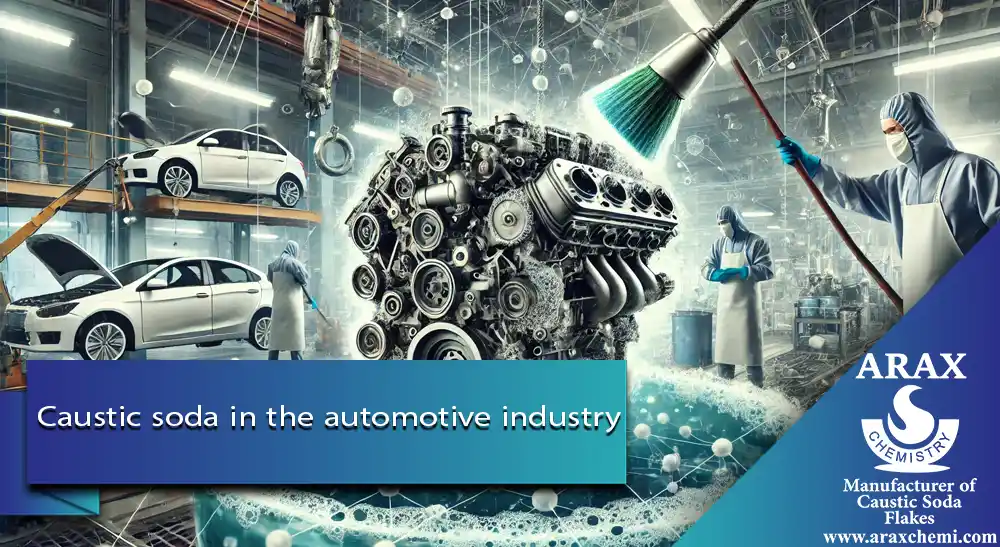In the fast-paced world of automotive manufacturing, maintaining and optimizing the performance of machinery is of paramount importance. One of the key chemicals that plays a significant role in these processes is caustic soda also known as sodium hydroxide. Imagine complex and expensive machinery struggling against contamination and deposits without the aid of this crucial substance. Caustic soda, with its unique ability to dissolve fats and deposits, acts as a hidden hero behind the scenes of the automotive industry. This substance not only aids in cleaning and maintaining parts but also plays a role in production processes. In this article, we aim to provide a comprehensive and detailed examination of the applications and uses of caustic soda in the automotive industry and show how this fascinating product works. Also, if you intend to buy caustic soda for your company, you can refer to the caustic soda price page and contact our colleagues if necessary.
History of Caustic Soda Use in the Automotive Industry
The use of caustic soda in the automotive industry dates back to the mid-20th century. With technological advancements and the increase in the number of vehicles, the need for chemicals for cleaning also increased. Caustic soda, due to its ability to dissolve fats and deposits, quickly found its place in this industry. In recent decades, the use of sodium hydroxide has increased due to the development of new technologies and the growing need for more precise cleaning.
Chemical and Physical Properties of Caustic Soda

Caustic soda (NaOH) is a white, solid chemical compound that is highly soluble in water. This substance has strong alkaline properties, enabling it to react with organic and inorganic materials to dissolve deposits and fats. These characteristics make caustic soda an effective agent in cleaning and descaling processes.
Applications of Caustic Soda in Cleaning Machine Parts
One of the most important applications of caustic soda in the automotive industry is **cleaning parts**. Due to its high ability to dissolve fats and deposits, this substance is widely used in washing and cleaning processes. Sodium hydroxide can effectively remove oils, greases, and other surface contaminants, which in turn enhances the efficiency and longevity of parts.
Use of Caustic Soda in Metal Parts Production
Interestingly, caustic soda is also used in some metal parts production processes. This substance can act as a catalyst in certain chemical reactions required for producing parts. Additionally, caustic soda can be used in the post-production washing processes to remove any chemical residues or surface contaminants. These applications improve the final quality of produced parts and ensure they are free of any additional contaminants or deposits.
Method of Using Caustic Soda in Cleaning Automotive Parts
As previously mentioned, caustic soda is a highly alkaline substance with numerous industrial applications, including in the leather industry, olive sweetening industry, water purification, etc. For more information on the uses of caustic soda, you can refer to the article on **applications of caustic soda in various industries**. We have explained the roles of caustic soda in this major industry, and now we intend to tell you how to use this substance effectively. Follow along.
First, caustic soda must be mixed with water (as needed). Immerse the engine parts covered in oil and grease into this solution or spray the solution onto the parts using washing equipment. After some time, depending on the dirtiness of the part, remove the part from the solution and rinse it with clean water to completely remove the chemical solution from the surface.
Another method involves producing biodiesel. In this process, you need vegetable or animal oil. After obtaining the oil, mix it with caustic soda, heat the mixture, and stir it to perform the transesterification reaction. After the reaction, you can separate the biodiesel from the glycerin, creating a new cleaning solution.
Advantages of Using Caustic Soda in the Automotive Industry

The use of caustic soda (sodium hydroxide) in the automotive industry has numerous advantages. This substance, as a powerful cleaner, can effectively dissolve deposits and fats, resulting in cleaner machinery parts and improved performance and longevity. Removing deposits and fats reduces wear and corrosion of parts, lowering maintenance and repair costs. Additionally, using caustic soda in production and cleaning processes smooths the surfaces of parts, preparing them for subsequent processes and enhancing the final product quality. Due to its diverse applications and cost-saving benefits, caustic soda is a powerful tool for improving production processes and increasing customer satisfaction.
Challenges and Disadvantages of Using Caustic Soda
While caustic soda has many benefits, its use comes with challenges and disadvantages. One of the main challenges is the need for specific safety precautions during its use. Additionally, caustic soda can cause corrosion in some metals and other materials, potentially reducing the lifespan of parts. Proper management of waste generated from caustic soda use is another important challenge that must be addressed.
Safety and Management of Caustic Soda in an Industrial Work Environment
Using caustic soda requires specific safety precautions. Due to its strong alkaline properties, caustic soda can cause chemical burns and damage to skin and eyes. Therefore, using protective equipment such as gloves, safety glasses, and protective clothing is essential. Moreover, storage and handling of caustic soda must be done carefully to prevent any potential accidents. Training employees on the correct and safe use of caustic soda is also a crucial aspect to consider.
Alternative Methods for Cleaning and Production in Automotive Manufacturing
Given the challenges and disadvantages of using caustic soda in the automotive industry, some alternative methods are also employed. These methods include using less hazardous chemicals and mechanical cleaning methods. Although these methods may be more expensive, they offer greater safety and environmental protection. Choosing the appropriate method for cleaning and producing parts depends on the specific machinery and conditions of each industry.

Conclusion
Caustic soda plays a vital role in the automotive industry. Due to its strong alkaline properties and ability to dissolve fats and deposits, it is very useful in cleaning and production processes. Although using caustic soda has its challenges and disadvantages, its benefits in enhancing the efficiency and longevity of parts, improving product quality, and reducing maintenance and repair costs cannot be overlooked. By following safety precautions and proper management, the benefits of caustic soda can be maximized.
Overall, caustic soda is a key chemical in automotive manufacturing, and its proper use can significantly improve the performance and efficiency of machinery. It is essential to ensure that the caustic soda used in this industry has high purity. Arax Chemi, with its production of caustic soda with an incredible purity of 99%, is an excellent choice for this purpose. For more information, you can visit our main page.
Frequently Asked Questions
- How can caustic soda be used safely in automotive manufacturing?
To use caustic soda safely, it is necessary to use protective equipment such as gloves, safety glasses, and protective clothing. Additionally, training employees on the correct and safe use of caustic soda is crucial. - What are the advantages of using caustic soda in cleaning automotive parts?
Caustic soda can effectively dissolve fats and deposits, enhancing the efficiency and longevity of automotive parts. It also helps improve the final product quality. - What alternative methods exist for cleaning and producing automotive parts?
Alternative methods include using less hazardous chemicals and mechanical cleaning methods. These methods may be more expensive but offer greater safety and environmental protection.
